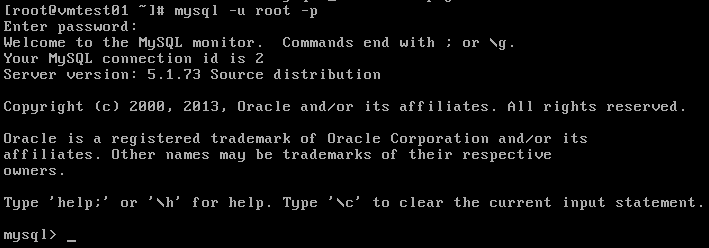“如何在Linux(CentOS)下重置MySQL根(Root)密码”的版本间的差异
来自YTYZX有图有真相的百科
| 第6行: | 第6行: | ||
3.输入“service mysqld stop”命令停止mysqld服务。 | 3.输入“service mysqld stop”命令停止mysqld服务。 | ||
[[File:MySQLRoot3.png]] | [[File:MySQLRoot3.png]] | ||
| + | 4.输入“mysqld_safe --skip-grant-tables &”命令以无密码方式进入MySQL安全模式。 | ||
| + | [[File:MySQLRoot4.png]] | ||
| + | 5.输入“mysql -u root”并按回车键即可。 | ||
| + | [[File:MySQLRoot5.png]] | ||
| + | 6.输入“use mysql;”挂载数据库。 | ||
| + | 注意:请勿忘记在最后输入分号(;)。 | ||
| + | [[File:MySQLRoot6.png]] | ||
| + | 7.输入"update user set password=password("New9ssw0rd") where user='root';"将Root密码修改为New9ssw0rd。 | ||
| + | [[File:MySQLRoot7.png]] | ||
| + | 8.输入"flush privileges;"更新权限。 | ||
| + | [[File:MySQLRoot8.png]] | ||
| + | 9.输入“quit”并按回车键退出。 | ||
| + | 注意:此处不需输入分号。 | ||
| + | [[File:MySQLRoot9.png]] | ||
| + | 10.输入"service mysqld restart"重启mysqld服务。 | ||
| + | [[File:MySQLRoot10.png]] | ||
| + | 11.输入“mysql -u root -p”并按回车键提示输入密码。 | ||
| + | [[File:MySQLRoot11.png]] | ||
| + | 12.输入新密码New9ssw0rd并按回车键,提示已经成功登录。 | ||
| + | [[File:MySQLRoot12.png]] | ||
2016年7月3日 (日) 18:57的版本
本例中以CentOS6.6下修改MySQL5.1.73举例说明。
1.首先输入“service mysqld status”查看当前mysql服务状态,下图显示正在mysqld服务正在运行中。
2.输入“killall -TERM mysqld”命令停止所有的mysqld进程。
3.输入“service mysqld stop”命令停止mysqld服务。
4.输入“mysqld_safe --skip-grant-tables &”命令以无密码方式进入MySQL安全模式。
5.输入“mysql -u root”并按回车键即可。
6.输入“use mysql;”挂载数据库。 注意:请勿忘记在最后输入分号(;)。
7.输入"update user set password=password("New9ssw0rd") where user='root';"将Root密码修改为New9ssw0rd。
8.输入"flush privileges;"更新权限。
9.输入“quit”并按回车键退出。 注意:此处不需输入分号。
10.输入"service mysqld restart"重启mysqld服务。
11.输入“mysql -u root -p”并按回车键提示输入密码。
12.输入新密码New9ssw0rd并按回车键,提示已经成功登录。









